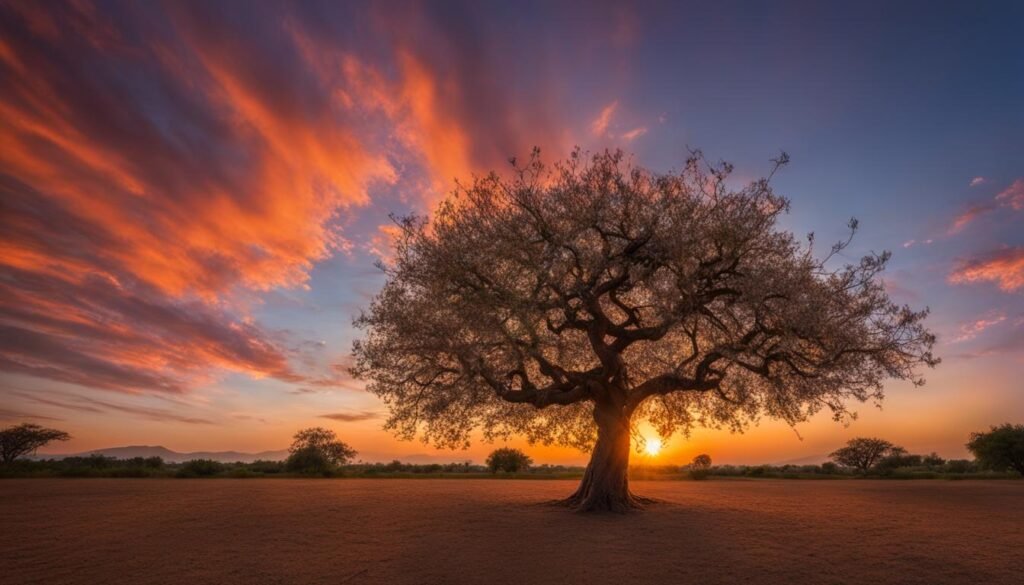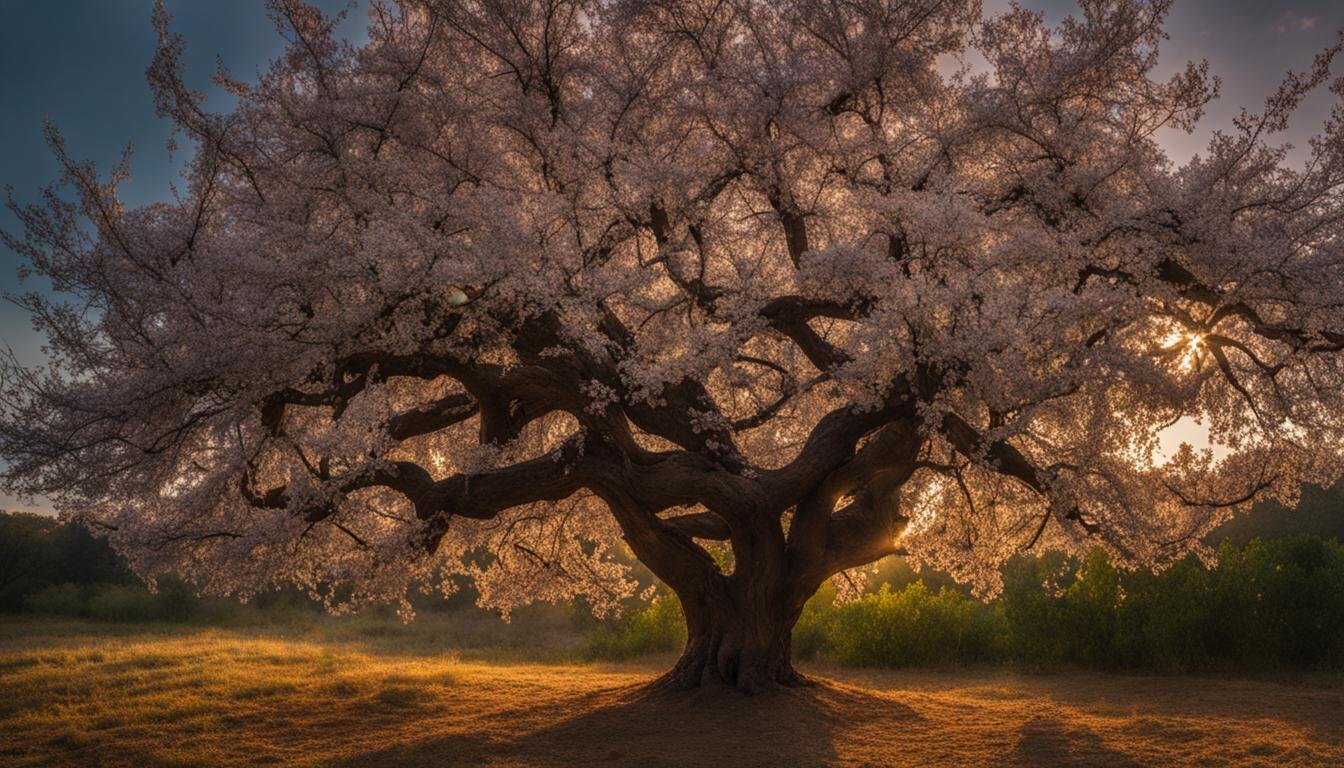Almond tree folklore is steeped in rich traditions and holds immense cultural significance in the United States. From captivating tales and myths to the symbolic meaning attributed to their blossoms, almond trees have woven themselves into the fabric of US folklore. Join me on a journey to delve into the captivating world of almond tree folklore and discover the enchantment and cultural heritage they embody.
In this article, we will explore the legends, historical significance, and symbolic meanings associated with almond trees. We will uncover the folklore beliefs and superstitions surrounding these majestic trees, and how they have shaped art, literature, and contemporary culture. Almond tree folklore is not limited to any specific region or culture, and its allure spans across the globe. Through the exploration of almond tree folklore, we will gain a deeper understanding of the universal appeal and cultural significance of these magnificent trees.
Key Takeaways:
- Almond tree folklore holds immense cultural significance in the United States.
- Legends and myths surrounding almond trees captivate the imagination and highlight their symbolic meaning.
- Almond trees have played a significant role in history, symbolizing rebirth, fertility, and prosperity.
- Almond tree folklore is prevalent in various cultures worldwide and is deeply rooted in tradition and belief.
- Almond tree festivals and celebrations bring communities together to honor the cultural heritage of these majestic trees.
The Legend of Almond Blossoms
Almond tree folklore is filled with captivating legends and tales that have been passed down through generations. One of the most famous legends is the Legend of Almond Blossoms, which originates from the city of Chelb in the Algarve region of Portugal. The legend tells the story of an Arab king named Ibn-Almundim and his love for a princess named Gilda.
According to the legend, Princess Gilda fell ill and longed for the snow from her home in Northern Europe. In a gesture of love and longing, King Ibn-Almundim had almond trees planted throughout the kingdom to mimic the white petals of snow. The blossoming almond trees brought comfort to Princess Gilda, and she was cured of her sadness. Thus, the Legend of Almond Blossoms became a cherished part of almond tree folklore, symbolizing love, devotion, and the power of nature.
The Legend of Almond Blossoms: “In the city of Chelb, an Arab king plants almond trees to bring comfort to his beloved princess, who longs for the snow of her homeland. The blossoming trees heal her sadness, becoming a timeless symbol of love.”
This enchanting legend showcases the deep-rooted beliefs and folklore surrounding almond trees. It reflects the cultural significance attributed to these majestic trees and their blossoms, which continue to hold a special place in folklore beliefs about almond trees across different cultures and traditions.

The Symbolism of Almond Blossoms
The Legend of Almond Blossoms is just one example of how almond tree folklore has impacted culture and symbolism. The blossoming almond trees carry a symbolic meaning of hope, renewal, and beauty. Their delicate white petals are often associated with purity, innocence, and new beginnings. In many cultures, almond blossoms are seen as a symbol of the circle of life and the ever-changing seasons.
Almond tree folklore often portrays these blossoms as a source of comfort, healing, and happiness. They represent the power of nature to uplift spirits and bring joy. The symbolism of almond blossoms is deeply ingrained in folklore beliefs about almond trees, making them a cherished and revered symbol in various cultures around the world.
Comparing Folklore Beliefs
| Region | Folklore Belief |
|---|---|
| Mediterranean | Planting an almond tree near a home brings good luck and protection. |
| Asian | Almond blossoms have the power to ward off evil spirits and bring blessings and abundance. |
| Middle East | Almond leaves, nuts, and oil possess medicinal properties and are used in traditional remedies. |
These comparisons highlight the diverse folklore beliefs surrounding almond trees and their various parts in different regions. From good luck and protection to healing properties, almond tree folklore reflects the deep connection between nature, spirituality, and cultural traditions.
Historical Significance of Almond Trees
Throughout history, almond trees have held immense historical folklore and cultural significance. Across different civilizations and time periods, these majestic trees have been revered for their beauty, resilience, and nourishing fruits. Mentions of almond trees can be found in texts as ancient as the Bible, where they are associated with symbols of rebirth, fertility, and prosperity.
In ancient cultures, almond trees were seen as a representation of renewal and the cycle of life. Their early blossoming made them a symbol of hope and new beginnings. The almond fruit itself, with its sweet and nourishing taste, became a symbol of happiness, fertility, and good fortune.
From the Middle East to the Mediterranean and beyond, almond trees have made a lasting impact on folklore beliefs and traditions. They have been associated with myths, legends, and even gods and goddesses in various mythologies. Their historical significance is deeply rooted in the traditions and customs of communities around the world.
The Almond Tree in Ancient Texts
“The almond tree, a symbol of renewal and prosperity, is mentioned in ancient texts such as the Bible. Its blossoms and fruits have been cherished for their beauty and nourishing properties.”
Almond trees have left their mark not only in ancient texts but also in archeological discoveries. The artifacts and paintings found in historical sites reveal the cultural significance of almond trees in daily life, rituals, and ceremonies of ancient civilizations.
The historical folklore of almond trees serves as a testament to their enduring presence and power in human imagination. The symbolism and cultural significance associated with these trees continue to be cherished and celebrated to this day.
Symbolic Meaning of Almond Trees
Almond trees hold a deep symbolic meaning in various cultures and folklore beliefs. These majestic trees are often associated with themes of hope, new beginnings, and beauty due to their early blossoming. In many traditions, almond trees symbolize purity, fertility, and the circle of life. The almond fruit itself is considered a symbol of happiness, abundance, and good fortune.
According to Greek mythology, almond trees were believed to represent immortality and renewal. In Norse mythology, these trees were associated with love and fertility. The symbolic meaning of almond trees varies across different cultures, reflecting the diverse folklore beliefs that surround them.
To showcase the symbolic significance of almond trees, let’s take a look at the following table:
| Symbolic Meaning | Cultures |
|---|---|
| Hope and new beginnings | Greek, Middle Eastern |
| Beauty and purity | Chinese, Persian |
| Fertility and abundance | Norse, Egyptian |
| Circle of life | Aztec, Native American |
The diverse symbolic meanings attributed to almond trees highlight their universal appeal and the cultural significance they hold. Whether representing hope, beauty, or fertility, these trees continue to inspire awe and capture the imagination of people around the world.
Almond Tree Folklore in American History
The rich traditions of almond tree folklore have deeply influenced the cultural heritage of the United States. From the early days of settlement to the present, almonds have played a significant role in American history and folklore. These majestic trees have been associated with agricultural traditions, symbolizing the resilience and perseverance of the early pioneers who settled new territories.
One noteworthy example of almond tree folklore in American history is the tales surrounding Almond Grove Park in California. This historic park, nestled among almond orchards, has become a symbol of the region’s agricultural heritage. It serves as a gathering place for locals and visitors alike, allowing them to immerse themselves in the enchanting world of almond tree folklore.
“Almond trees have become a part of the cultural fabric of the United States, representing the country’s connection to the land and its rich agricultural heritage.”
The folklore surrounding almond trees in American history is a testament to the deep-rooted connection between people and the land. It reflects the enduring impact of these majestic trees on the lives and traditions of the American people.

Table: Almond Tree Festivals in the United States
| Festival Name | Location | Date |
|---|---|---|
| Almond Blossom Festival | Ripon, California | February |
| Almond Festival | Capay Valley, California | February |
| Almond Festival | Crockett, California | April |
| Almond Blossom Festival | Quartz Hill, California | April |
| Almond Festival | Hilmar, California | September |
Almond tree festivals and celebrations are held in various regions across the United States, paying homage to the cultural significance of these majestic trees. These festivities bring communities together, showcasing the enchantment and beauty of almond tree folklore.
Folklore Beliefs and Superstitions
Folklore beliefs and superstitions surrounding almond trees are prevalent in various cultures. These age-old beliefs often center around the magical and protective properties attributed to almond trees. For example, some believe that planting an almond tree near a home brings good luck and protection, while others think that the blossoms of the almond tree have the power to ward off evil spirits or bring blessings and abundance.
Almond tree folklore also includes beliefs about the medicinal properties of almond leaves, nuts, and oil. Many traditional remedies and herbal practices incorporate almond-related ingredients for their potential health benefits. These folklore beliefs highlight the deep connection between almond trees and the spiritual and holistic wellbeing of different communities.
“Planting an almond tree near my house has always been a tradition in my family. We believe it brings good luck and protects us from negative energies,” says Maria, a folklore enthusiast from Portugal.
Folklore Beliefs in Different Cultures
- In Greek mythology, almond trees were believed to be a symbol of immortality and renewal.
- In Norse mythology, almond trees were associated with fertility and love.
- In Chinese folklore, almond trees are believed to bring good fortune and happiness.

These examples demonstrate the varied and fascinating folklore beliefs surrounding almond trees in different cultures. Whether it’s through planting almond trees for protection, cherishing their blossoms for their symbolic power, or exploring their potential healing properties, almond tree folklore continues to enrich our connection to nature and spirituality.
| Folklore Belief | Culture | Significance |
|---|---|---|
| Almond blossoms ward off evil spirits | Greek | Protection from negative energies |
| Planting almond trees brings good luck | Portuguese | Invokes positive energy and blessings |
| Almonds represent happiness and fertility | Chinese | Wishes for prosperity and joy |
Almond Tree Folklore in Art and Literature
The enchanting qualities of almond trees have inspired countless works of art and literature throughout history. From paintings depicting almond blossoms to poems and stories featuring almond trees as central motifs, the presence of almond tree folklore in art and literature is undeniable.

The cultural significance of almond trees is beautifully displayed during these festivals, as communities come together to honor their heritage and the folklore beliefs that have been passed down through generations. These celebrations not only showcase the beauty of almond trees in full bloom but also serve as a reminder of the deep-rooted connections between nature and human culture. Almond tree festivals and celebrations are an opportunity to immerse oneself in the enchanting world of almond tree folklore and experience the joy and unity that these majestic trees inspire.
Table: Almond Tree Festivals and Celebrations Around the World
| Region | Festival Name | Date |
|---|---|---|
| Mallorca, Spain | Fira de la Flor d’Ametler | February |
| Lalbagh, Bengaluru, India | Almond Blossom Festival | February |
| Capay Valley, California, USA | Capay Valley Almond Festival | February |
| Douro, Portugal | Mandorriarte Festival | March |
| Palermo, Sicily, Italy | Almond Blossom Festival | March |
These are just a few examples of almond tree festivals and celebrations that take place around the world. Each festival offers a unique experience, showcasing the local traditions, folklore beliefs, and cultural significance associated with almond trees in their respective regions. Attending one of these festivals is a memorable way to immerse oneself in the beauty and enchantment of almond tree folklore.
Almond Trees in Mythology
Almond trees have a mystical presence in various mythological tales and legends. In Greek mythology, these majestic trees were believed to be a symbol of immortality and renewal. They were associated with the story of Phyllis and Demophon, where Phyllis, the daughter of a king, was abandoned by her lover Demophon. Overwhelmed by grief, Phyllis took her own life under an almond tree, which later bloomed and became a symbol of eternal love and rebirth.
In Norse mythology, almond trees were linked to fertility and love. The goddess Frigg, known for her wisdom and protective nature, was often depicted with an almond branch in her hand. It was believed that the fragrance of the almond blossoms had the power to awaken passion and desire, making the almond tree a symbol of love and sensuality.
In Greek mythology, almond trees were a symbol of immortality and renewal, while in Norse mythology, they represented fertility and love.
These mythological associations highlight the enduring presence of almond trees in ancient cultures and their symbolic significance in shaping the beliefs and traditions of different civilizations.

Table: Traditional Uses of Almond Trees in Folklore Medicine
| Almond Tree Component | Traditional Folklore Uses |
|---|---|
| Almond oil | Moisturizing skin, promoting hair health, reducing inflammation |
| Almond leaves | Brewing herbal teas for cough, easing stomachaches, soothing skin irritations |
| Almond tree bark | Used to create tinctures for boosting immunity, promoting digestive health |
| Almond tree blossoms | Used in aromatherapy for relaxation, relieving anxiety, and improving sleep |
While the scientific efficacy of these traditional uses varies, they remain an integral part of almond tree folklore. The deep-rooted beliefs and practices surrounding almond trees in healing and medicine highlight the enduring connection between nature and wellbeing in various cultures.
Almond Tree Folklore Around the World
Almond tree folklore is a fascinating aspect of cultural heritage that can be found in various regions around the world. These magnificent trees hold great cultural significance and are the subject of many folklore beliefs and traditions. Whether it’s the symbolic meaning attributed to almond trees or the tales and legends woven around them, exploring almond tree folklore provides a glimpse into the rich tapestry of human imagination and cultural diversity.
In Mediterranean and Middle Eastern cultures, almond trees are often associated with new beginnings, hope, and renewal. They symbolize the arrival of spring and the promise of a fruitful year ahead. The almond blossom, with its delicate beauty and fragrant aroma, is seen as a harbinger of good fortune and prosperity. Almond tree folklore in these regions is infused with stories of love, longing, and the enduring power of nature.
In Asian cultures, almond trees have their own unique folklore beliefs. In Chinese folklore, almond trees are believed to have the power to ward off evil spirits and bring good luck. They are often planted near homes and temples for protection and blessings. In Japanese folklore, almond trees symbolize endurance and resilience, representing the ability to overcome obstacles and thrive in challenging conditions. Almond tree folklore in Asia reflects the deep reverence and spiritual connection that people have with these trees.
Almond tree folklore also spans across the Americas, where the trees have become an integral part of cultural traditions. In the United States, almond tree folklore is rooted in the country’s agricultural heritage and the pioneering spirit of early settlers. From the folklore surrounding almond orchards in the American West to the celebrations of almond tree festivals in California, these traditions showcase the enduring cultural significance of almond trees in American culture.

Table: Symbolic Meanings Associated with Almond Trees
| Symbolic Meaning | Description |
|---|---|
| Renewal | The early blossoming of almond trees represents the renewal of life and the arrival of spring. |
| Hope | Almond trees symbolize hope and the promise of new beginnings. |
| Connection to the Divine | Almond trees are often associated with spirituality and can evoke a sense of connection to the divine. |
| Peace and Harmony | The presence of almond trees in gardens creates a serene and harmonious atmosphere. |
| Transformation | Almond trees symbolize personal growth, transformation, and the potential for change. |
Almond Tree Folklore in Contemporary Culture
Almond tree folklore continues to weave its enchanting tales in modern society, influencing various aspects of contemporary culture. From art and literature to fashion and design, the cultural significance of almond trees is evident in diverse creative expressions. These majestic trees, with their rich symbolism and deep-rooted folklore beliefs, have found their way into popular media, capturing the imagination of people worldwide.
One cannot overlook the allure of almond tree motifs in design and fashion. The delicate blossoms and distinctive shape of the almond tree have become popular inspirations for patterns and prints, adding a touch of elegance and symbolism to clothing and accessories. Whether in jewelry adorned with almond tree motifs or home decor featuring almond tree-inspired designs, these artistic expressions pay tribute to the cultural significance of almond trees and serve as reminders of their folklore beliefs.
The enchantment of almond tree folklore has also made an impact on the world of tourism. Almond tree destinations, such as almond orchards in bloom or festivals celebrating the blossoming season, attract visitors from near and far who seek to experience the beauty and cultural heritage associated with these majestic trees. Almond tree folklore in contemporary culture extends beyond the boundaries of storytelling, becoming a tangible experience that allows people to connect with nature and history.

Inspired Quotes
“The almond tree stands as a living testament to our connection with nature and the enduring power of folklore beliefs.” – Anonymous
“When I gaze upon the blossoming almond trees, I am reminded of the timeless stories and profound symbolism they hold, enriching our lives with their presence.” – Unknown
Conclusion
In conclusion, almond tree folklore is a captivating tapestry of tales, traditions, and symbolic meanings that has fascinated humanity for centuries. From the Legend of Almond Blossoms to the historical significance of almond trees, these majestic trees hold a special place in the cultural heritage of various communities around the world. Their beauty, resilience, and nourishing fruits have made them symbols of hope, new beginnings, and prosperity in many cultures.
Exploring the enchanting world of almond tree folklore allows us to connect with the deep-rooted beliefs and cultural significance tied to these trees. Almond trees have played integral roles in history, mythology, art, and literature, serving as sources of inspiration and enduring symbols of beauty and purity. Their presence in symbolic gardens and celebrations further highlights their importance in society.
Today, almond tree folklore continues to make an impact in contemporary culture. From the incorporation of almond tree motifs in design and fashion to the inclusion of almond tree symbolism in popular media, these folklore beliefs and traditions find expression in our modern society. Almond trees have become tourist attractions, attracting people who are drawn to their enchantment and allure.
Overall, almond tree folklore reflects the lasting influence and significance of these trees in our cultural heritage. By delving into the rich world of almond tree folklore, we gain a deeper understanding of the traditions and symbolism that these majestic trees embody.
FAQ
What is almond tree folklore?
Almond tree folklore refers to the traditions, tales, and beliefs associated with almond trees. It encompasses legends, symbolic meanings, and cultural significance attributed to these majestic trees.
What is the Legend of Almond Blossoms?
The Legend of Almond Blossoms is a famous tale about an Arab king who planted almond trees to mimic snow petals for his beloved princess. The blossoming almond trees helped cure her sadness, becoming a part of almond tree folklore.
How have almond trees been historically significant?
Almond trees have been mentioned in ancient texts and associated with rebirth, fertility, and prosperity. They have played a role in agricultural traditions, settling new territories, and the perseverance of early pioneers.
What is the symbolic meaning of almond trees?
Almond trees symbolize hope, new beginnings, and the circle of life. They are associated with beauty, purity, happiness, fertility, and good fortune. The symbolic meaning varies across cultures and reflects diverse folklore beliefs.
How are almond trees connected to American history?
Almond trees have been a part of the cultural fabric of the United States. They have been associated with agricultural traditions, the settling of new territories, and the country’s rich agricultural heritage.
What are some folklore beliefs and superstitions about almond trees?
Some believe that planting an almond tree near a home brings good luck and protection. Others believe that almond blossoms can ward off evil spirits or bring blessings and abundance. Almond leaves, nuts, and oil are also believed to have medicinal properties.
How have almond trees influenced art and literature?
Almond trees have inspired paintings, poems, and stories. They are depicted as central motifs, reflecting their beauty, symbolism, and connection to nature in various artistic expressions.
Are there any almond tree festivals and celebrations?
Yes, almond tree festivals and celebrations are held in regions with a deep connection to almond tree folklore. These festive events involve music, dance, food, storytelling, and a celebration of the blooming almond trees.
What is the role of almond trees in mythology?
Almond trees have been associated with immortality, renewal, fertility, and love in various mythological tales. They are connected to gods, goddesses, and magical beings in different mythological traditions.
What is the healing and medicinal significance of almond trees in folklore?
Almond oil and leaves have been used for their nourishing and medicinal properties. Almond tree folklore attributes magical and protective properties to different parts of the tree, highlighting their connection to holistic wellbeing.
Is almond tree folklore specific to certain cultures?
Almond tree folklore is found across the world, from the Mediterranean to the Americas. Each culture has its unique traditions, beliefs, and stories associated with almond trees, reflecting the universal appeal and cultural significance of these trees.
How are almond trees represented in symbolic gardens?
Almond trees are planted in symbolic gardens to represent themes of renewal, hope, and connection to the divine. They add depth and meaning to the overall design, reflecting the folklore and symbolism associated with these trees.
How does almond tree folklore influence contemporary culture?
Almond tree folklore finds expression in design, fashion, and popular media. It has become a popular attraction for tourists seeking to experience the enchantment and beauty of these trees firsthand.
What can we learn from almond tree folklore?
Almond tree folklore allows us to connect with rich traditions, symbolism, and cultural heritage. It highlights the enduring impact and relevance of these stories and beliefs and their universal appeal across diverse communities.




